CityEngine 2009.2 procedural modeler released
16/09/09 11:01 Filed in: News
New CityEngine 2009.2 Version Available Now for Download!
Significant improvements in performance allow for the design and modeling of megacities with over 500'000 buildings.
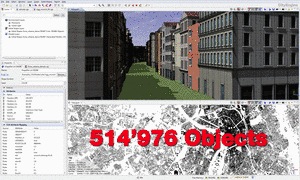
Procedural Inc. today announced the CityEngine 2009.2, the latest version of its groundbreaking software for the fast creation, visualization and analysis of large 3D cities. The software is used by high-profile companies such as Foster+Partners, Microsoft, Navteq, Boeing, IBM, Thales, Blizzard, Square Enix, etc. and was awarded Killer Technology 2009 by 3D World magazine Procedural Inc., an innovative software company located in Zurich, Switzerland, is creator of the world’s foremost procedural modeling technology. With the CityEngine, Procedural Inc.’s graphics experts have developed a radically different 3D application that allows professional users in entertainment, architecture and urban planning to efficiently design cities. "CityEngine 2009.2 introduces significant improvements in performance and overall stability", says Pascal Mueller, CEO Procedural Inc. "Furthermore, with the integration of map projection standards and corresponding accuracy enhancements, the CityEngine is now, together with its unique reporting functionality, the perfect tool for sustainable urban planning such as accurate simulation and evaluation of new city developments."
Key Highlights of the CityEngine 2009.2
- Large Data Set Support (over 500'000 buildings on 64bit)
- Map Projections (over 80 projections are supported)
- Accuracy Enhancements (enabling high-precision at global scale )
- 3DS Export (plus advancements of Collada and FBX export)
Pricing and Availability
A free 30-day trial version is available for download. The software can be purchased via Procedural Inc.’s website, or by telephone order at +41 76 720 3303. The CityEngine retails from a starting price of $ 3’450.
Cinema 4D R11.5 Released
02/09/09 23:13 Filed in: News
Maxon Releases Cinema 4D Release 11.5
by Albert Kiefer

Maxon has just released Cinema 4D R11.5 to the general public.

by Albert Kiefer

Maxon has just released Cinema 4D R11.5 to the general public.

Key Highlights of CINEMA 4D Release 11.5
- Superior Rendering Performance Including New Bucket Rendering
- Enhanced Picture Viewer
- Improved Interoperability and Integration
- Numerous improvements have been made to CINEMA 4D's highly praised connectivity to Adobe® After Effects®, including support for additional object types.
- Support for Apple® Motion now includes the export of 3D data.
- Support for Autodesk® FBX® 2010.0 allows for quick and easy interchange between a variety of 3D applications.
Powerful New Motion Graphics Capabilities
Release 11.5 promises a tighter integration with Apple’s recent Final Cut Studio upgrade, more specifically with Apple Motion3 from that package with its strengthened 3D capabilities.Support For the New Generation of Operating Systems
- Apple - R11.5 is fully compatible with Mac OS X Snow Leopard, including access to up to 64GB of virtual memory. This is a great relief since it’s always a wait-and-see if a new OS is supported by current products.
- Microsoft - R11.5 is fully compatible with Windows 7, including enhanced file dialog.
CityEngine Review
26/07/09 12:31
CityEngine
Incredibly powerful urban habitation modeling tool
by Albert Kiefer
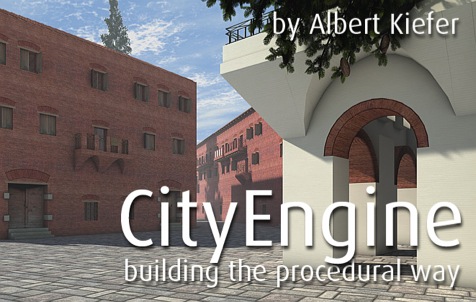
Both in Architectural visualizations, in certain games situations but also in archeologic reconstructions it is sometimes inevitable to create or recreate an urban environment. A habitated area that shows human presence. Historically this habitation grows from a number of conditions present at a certain geographic location such as a path, a road, a river, etc. People will start settling in places like these and build houses and streets along trading routes that establish themselves in a village that evolves into a town and than maybe into a huge metropolitan city.
Swiss company Procedural have developed a software specifically for this purpose and it’s doing a fantastic job at it. However it’s not your regular easy drag and drop type of software. Obviously CityEngine does provide a great drag and drop functionality. It supports this by dragging rules based procedures to pre-selected surface areas. But it is by no means a software for the casual user. Obviously at its price point starting at 3450 US Dollars (there is an educational license for just 695 US Dollars), this software is not intended for the casual user but for professionals in the architecture, games, film, archeologic and general visualization companies for which the seemingly steep pricing is not a problem since the software will earn itself back very quickly.
Procedurally Structured
So how does CityEngine work its magic? Well it starts more or less the same way a city develops over time. So basically it starts from simple road network. You can for example import xml, dxf data from any source (like openstreetmap.org) and start building from these street networks, or you can have CityEngine generate a network for you based on a series of procedural rules.
After the network is generated you can command CityEngine to draw lots between those streets. These can be subdivided further in smaller lots. After this process of subdivision is complete (you can, by selecting areas, constrain the generation of lots to areas you like) CityEngine can start drawing buildings onto each individual lot or to sets of lots that you pre select. This process is very straightforward and in no time you have created a very convincing urban area with lots of different buildings.
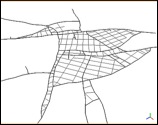
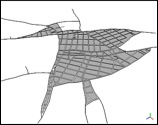
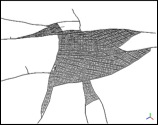
from basic street network to elaborate lot subdivision is just a simple three click process
Now generating networks of streets and subdividing the areas between these streets with small lots of ground is nice. But obviously there, where the houses start to build themselves is where the real CityEngine magic starts to work. CityEngine does this by a procedural modeling language and they have called this modelling structure the Shape Grammar. In the shape grammar of a particular building they write down a set of rules that geometry, and even texturemaps, will behave to depending on a specific situation. This way you can create stunningly adaptive buildings that seems to just know how to behave under certain conditions.
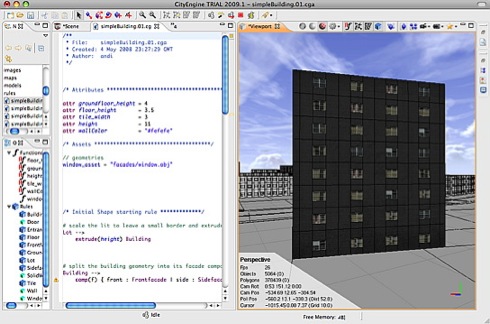
a section of shape grammar code next to a building (might not be the building for this code)
Make a building taller and it automatically adds new floors to compensate for the extended height. Make it wider and the structure adds more windows to avoid large blind walls.
In their free 30 day demo version they have a set of shape grammar scripts to recreate the Petronas Towers, the Parthenon and the Candler building. That way you can start to dissect how to work with this procedural scripting language.
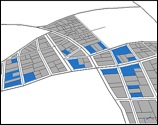
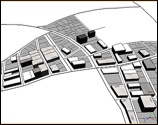
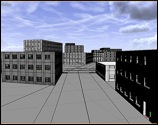
by selecting subdivided lot sections each can be assigned instructions via shape grammar rules
CityEngine is very powerful for games development too because it can simultaneously generate different levels of details (for instance for distant buildings in relation to a player, or for a simpler collision detection geometry model). And it can export in a variety of formats for popular games engines.
All in all CityEngine is a very powerful package for modeling and simulating urban civilizations. They have even done a great job of rebuilding ancient Pompei (take a look at that movie here). It’s even a great conceptual tool for quickly investigating different massing and shape strategies by architects. But it is certainly not for the casual user. They have now expanded their terrain to include a Mac version as well but I have had serious issues with both the graphics engine and professional Mac video card (ATI Radeon X1900 XT with 512Mb Vram) and also Mac formatted xml files exported from open streetmap (it just does not read them because of a different file naming structure. In my case I had to disable the CityEngine shader on my MacPro 8 core Xeon system because it basically stopped interacting with even a one house shaded setup.
I can even very well see a lower cost version being developed that will sell based on selling rules sets for buildings and simulated streets and lots in a more consumer oriented way wich will certainlly find its way to broader user base.
Incredibly powerful urban habitation modeling tool
by Albert Kiefer

Both in Architectural visualizations, in certain games situations but also in archeologic reconstructions it is sometimes inevitable to create or recreate an urban environment. A habitated area that shows human presence. Historically this habitation grows from a number of conditions present at a certain geographic location such as a path, a road, a river, etc. People will start settling in places like these and build houses and streets along trading routes that establish themselves in a village that evolves into a town and than maybe into a huge metropolitan city.
Swiss company Procedural have developed a software specifically for this purpose and it’s doing a fantastic job at it. However it’s not your regular easy drag and drop type of software. Obviously CityEngine does provide a great drag and drop functionality. It supports this by dragging rules based procedures to pre-selected surface areas. But it is by no means a software for the casual user. Obviously at its price point starting at 3450 US Dollars (there is an educational license for just 695 US Dollars), this software is not intended for the casual user but for professionals in the architecture, games, film, archeologic and general visualization companies for which the seemingly steep pricing is not a problem since the software will earn itself back very quickly.
Procedurally Structured
So how does CityEngine work its magic? Well it starts more or less the same way a city develops over time. So basically it starts from simple road network. You can for example import xml, dxf data from any source (like openstreetmap.org) and start building from these street networks, or you can have CityEngine generate a network for you based on a series of procedural rules.
After the network is generated you can command CityEngine to draw lots between those streets. These can be subdivided further in smaller lots. After this process of subdivision is complete (you can, by selecting areas, constrain the generation of lots to areas you like) CityEngine can start drawing buildings onto each individual lot or to sets of lots that you pre select. This process is very straightforward and in no time you have created a very convincing urban area with lots of different buildings.



from basic street network to elaborate lot subdivision is just a simple three click process
Now generating networks of streets and subdividing the areas between these streets with small lots of ground is nice. But obviously there, where the houses start to build themselves is where the real CityEngine magic starts to work. CityEngine does this by a procedural modeling language and they have called this modelling structure the Shape Grammar. In the shape grammar of a particular building they write down a set of rules that geometry, and even texturemaps, will behave to depending on a specific situation. This way you can create stunningly adaptive buildings that seems to just know how to behave under certain conditions.

a section of shape grammar code next to a building (might not be the building for this code)
Make a building taller and it automatically adds new floors to compensate for the extended height. Make it wider and the structure adds more windows to avoid large blind walls.
In their free 30 day demo version they have a set of shape grammar scripts to recreate the Petronas Towers, the Parthenon and the Candler building. That way you can start to dissect how to work with this procedural scripting language.



by selecting subdivided lot sections each can be assigned instructions via shape grammar rules
CityEngine is very powerful for games development too because it can simultaneously generate different levels of details (for instance for distant buildings in relation to a player, or for a simpler collision detection geometry model). And it can export in a variety of formats for popular games engines.
All in all CityEngine is a very powerful package for modeling and simulating urban civilizations. They have even done a great job of rebuilding ancient Pompei (take a look at that movie here). It’s even a great conceptual tool for quickly investigating different massing and shape strategies by architects. But it is certainly not for the casual user. They have now expanded their terrain to include a Mac version as well but I have had serious issues with both the graphics engine and professional Mac video card (ATI Radeon X1900 XT with 512Mb Vram) and also Mac formatted xml files exported from open streetmap (it just does not read them because of a different file naming structure. In my case I had to disable the CityEngine shader on my MacPro 8 core Xeon system because it basically stopped interacting with even a one house shaded setup.
I can even very well see a lower cost version being developed that will sell based on selling rules sets for buildings and simulated streets and lots in a more consumer oriented way wich will certainlly find its way to broader user base.
ZBrush 3.2 for Mac OS X released
03/07/09 09:52

Pixologic have just released version 3.2 of their flagship product Zbrush. This release currently is only for Mac OS X.
The new version which is available for immediate download here contains the usual optimizations and bug fixes but more importantly contains some core functionality of the new goZBrush which is going to improve te workflow beteen ZBrush and Maya, Modo and Cinema 4D (I think the PC version will obviously support 3DS Max when it is released).
 more information about goZbrush can be found here
more information about goZbrush can be found hereAlso great new is that with the new release come two plug-ins that were supported by earlier versions (PC) of ZBrush but now are available to Mac users too. They are decimation master, a plug-in for simplifying the very heavy meshes that ZBrush can generate for use in production packages like Maya, Cinema 4D, and Modo. Not that it’s impossible to work with heavy meshes in the programs but often times it’s just not that practical in a production envirnoment to animate these very heavy files.


these plug-ins can be picked up right here